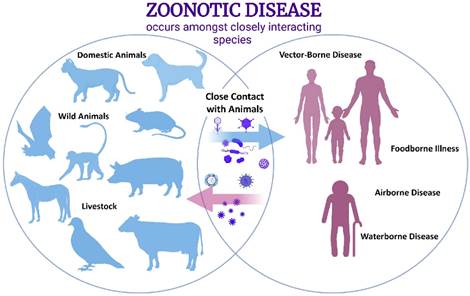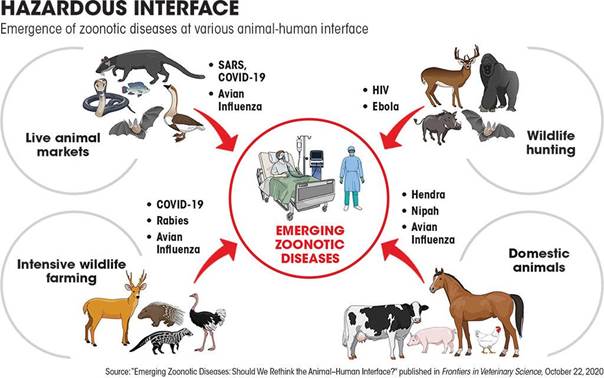Description

Disclaimer: Copyright infringement not intended.
Context
- A UN report shows that in the last 170 years, nine epidemics among livestock have spilled over to people; six of them have emerged since the 1990s. This frequent outbreak of zoonotic diseases in recent decades is clearly due to intensification of agriculture.

Agriculture and Livestock
- As agriculture expands and intensifies natural ecosystems are converted to farm or range land, interactions increase among humans and domesticated and wild animals.
- Artificial oceans of pigs and poultry in the hinterlands become mixing vessels for viruses from humans, livestock and wildlife, while other farmed animals simply act as bridging hosts, carrying the infection from wildlife to humans.
Must Read Article on One Health: https://www.iasgyan.in/daily-current-affairs/one-health-approach-37#:~:text=Examples%20of%20zoonotic%20diseases%20include,infections%20caused%20by%20Salmonella%2C%20E.
Zoonosis
- A zoonosis is an infectious disease that has jumped from a non-human animal to humans.
- Zoonotic pathogens may be bacterial, viral or parasitic, or may involve unconventional agents and can spread to humans through direct contact or through food, water or the environment. They represent a major public health problem around the world due to our close relationship with animals in agriculture, as companions and in the natural environment.
- Zoonoses can also cause disruptions in the production and trade of animal products for food and other uses.

Livestock and Zoonosis
- A report “Emerging human infectious diseases and the links to global food production”, published in Nature Sustainability in June 2019, highlights that 77 per cent of livestock pathogens are capable of infecting multiple host species, including wildlife and humans.
- And over the past 50 years, the global population of poultry has multiplied six times to nearly 36 billion; the number of pigs has almost doubled to 952.6 million; and cattle numbers have grown from 1.1 billion to 1.5 billion.
- Most of the increase in human and livestock densities are expected to occur in developing countries where disease surveillance, pest control, sanitation, and medical and veterinary care are limited.
- The maximum brunt of these is faced by poor farmers. A billion poor livestock farmers bear the burden of zoonotic diseases. They are the ones who live with animals.
India at risk
- According to International Livestock Research Institute (ILRI), India is among the four countries — the other three are Ethiopia, Nigeria and Tanzania — that suffer from the highest zoonotic disease burden, with widespread illness and death.
- In fact, of the 13 livestock diseases monitored by the National Institute of Veterinary Epidemiology and Disease Informatics (NIVEDI), four are zoonotic.
- These are:
- Anthrax (highly infectious bacterial illness that can affect a person’s skin, lungs or intestine when they come in contact with infected animals, eat contaminated meat or inhale the bacteria spores);
- Babesiosis (a life-threatening parasitic disease that can transmit to humans via tick bite, blood transfusion or from an infected mother to her baby);
- Fasciolosis (a parasitic worm infection that is acquired by eating contaminated watercress or other water plants); an
- Trypansomosis or sleeping sickness (a parasitic disease that causes fever, fatigue, dullness and swollen lymohnodes and is transmitted by tsetse flies).
- More such zoonoses are either endemic to the country or are re-emerging. One such is buffalopox.

Initiative taken
- To build a connected livestock disease programme that can integrate wildlife and human disease to inform about the movements and control of zoonotic diseases, the Department of Animal Husbandry and Dairying in 2020 launched the National Digital Livestock Mission (NDLM).
- It aims to tag all the 500 million major livestock in the country with a unique 12-digit identification (ID) number, just like the Aadhaar card for people.
- So far, 245 million animals have been tagged, with their details like age, breed, milk yield, vaccinations and dates of artificial insemination and delivery of calf, recorded in a central database.
- This ID will serve as the foundation for all state and national programmes, including vaccination. Disease modelling and surveillance for prevention and control of livestock diseases will be done through mobile veterinary units, connected with toll free helpline number, 1962.
Way Ahead
- India already has mobile dispensaries for livestock diseases. They should be strengthened and made accountable to panchayats.
- Scientists should visit villages once or twice a month for sampling and awareness.
- Vaccination should be done on the lines of polio eradication.
- Not all veterinary hospitals have cold storage facilities, which makes vaccines ineffective. We need to minimise this gap.
https://newsonair.gov.in/News?title=AMR-is-a-silent-and-invisible-pandemic-that-cannot-be-overshadowed-by-other-competing-public-health-priorities-%3A-MoS-Dr-Bharati-Pravin-Pawar&id=451320












